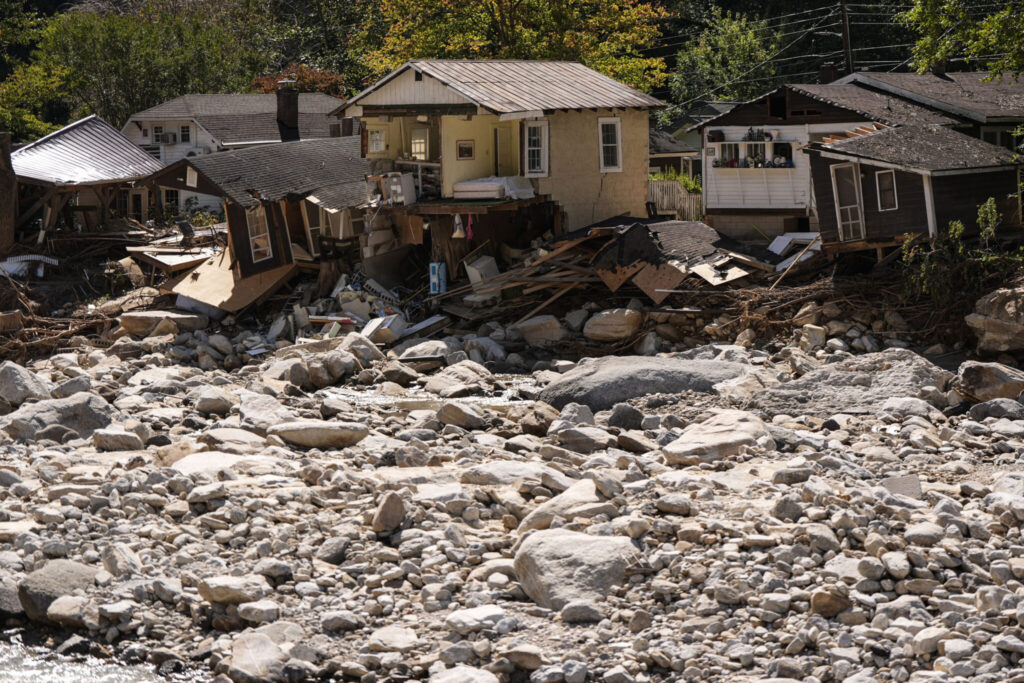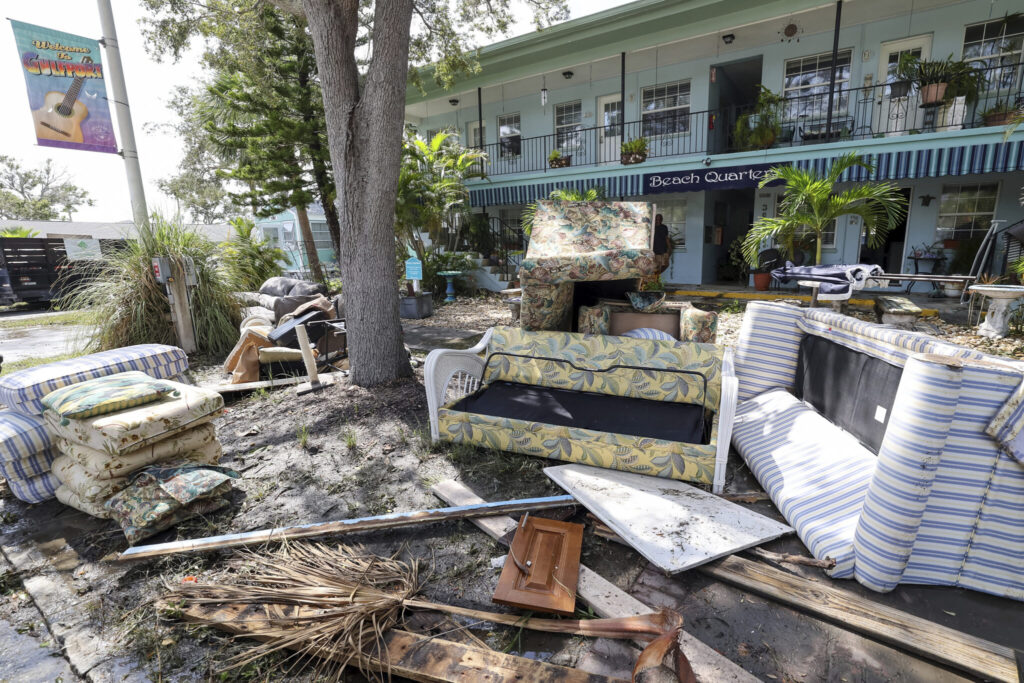Hurricane Helene/ flood insurance gap/ rebuilding after Helene/ Asheville flood damage/ U.S. flood insurance crisis/ FEMA flood program/ Newslooks/ Florida/ J. Mansour/ Morning Edition/ A week after Hurricane Helene struck the southeastern U.S., many homeowners are left grappling with how to rebuild without flood insurance. The Category 4 storm caused extensive flood damage, particularly in inland areas like western North Carolina, where many residents lack flood coverage. This leaves them facing potentially devastating financial consequences as they struggle to recover from one of the deadliest hurricanes to hit the mainland U.S. since Katrina.

Homeowners Grapple with Rebuilding After Helene Quick Looks
- Flood insurance gap: Many affected by Hurricane Helene do not have flood insurance, leaving them with limited options to cover damage costs.
- North Carolina devastation: Western North Carolina, including Asheville, was hit particularly hard by inland flooding, with homes, roads, and utilities destroyed.
- FEMA limitations: While FEMA provides some relief, its flood insurance program has coverage limits, leaving many homeowners without sufficient financial help.
- Rebuilding challenges: Without adequate insurance, some homeowners may face foreclosure or bankruptcy, while entire neighborhoods may never recover.
Homeowners Devastated by Hurricane Helene Struggle Without Flood Insurance
Deep Look
A week after Hurricane Helene made landfall, devastating inland areas of the southeastern United States, many homeowners are now grappling with the harsh reality of how to rebuild without flood insurance. The Category 4 storm, which first hit Florida’s Gulf Coast on September 26, brought trillions of gallons of water to several states, causing catastrophic flooding that left behind a trail of destruction stretching hundreds of miles inland.
The storm’s path was deadly, with more than 200 lives lost, making it the most lethal hurricane to strike the U.S. mainland since Hurricane Katrina in 2005. Western North Carolina, particularly the Asheville area, was among the hardest hit. Residents there are now facing the daunting task of rebuilding homes, roads, and infrastructure, often without the benefit of insurance to cover flood damage.
In Asheville’s Oak Forest neighborhood, towering trees that once provided shade over 1960s ranch-style homes became hazards when the remnants of Helene swept through the region on September 27. Julianne Johnson recounted how a giant oak crashed across her yard as she rushed upstairs to help her son. Although the tree mostly missed the house, the family’s basement flooded, and their roof was damaged.
“We have a blue tarp on the roof, and the carpet is waiting to go to the landfill,” Johnson said. With no cellphone or internet service after the storm, she wasn’t able to file a home insurance claim until four days later. “I don’t have an adjuster yet,” she added.
For homeowners like Johnson, the challenge goes beyond typical storm damage. While tree and roof damage may be covered by standard home insurance policies, flood damage is typically excluded. Without flood insurance, Johnson and others are left wondering how they will pay for the flood-related repairs.
Flood Insurance Gap
Insurance professionals have long warned that flood damage is typically not covered by standard home insurance policies, even though flooding can occur anywhere. Flooding can result from not just storm surges along the coast but also overflowing rivers and torrential rainstorms, such as those that accompanied Hurricane Helene.
In the U.S., most flood insurance is provided through the National Flood Insurance Program (NFIP), which is run by the Federal Emergency Management Agency (FEMA). This program was created over 50 years ago when private insurers began pulling back from offering flood coverage in high-risk areas. North Carolina has about 129,933 NFIP policies in place, but these are largely concentrated along the coast rather than in the mountainous areas of western North Carolina, which saw the most severe flooding from Helene.
“This disaster is going to financially devastate many people,” said Charlotte Hicks, a flood insurance expert who has worked extensively with North Carolina’s Department of Insurance. She explained that many homeowners in the region didn’t have flood insurance and would not be able to recover fully. “There are people who may go into foreclosure or bankruptcy because of this,” she added, noting that for some, their entire property was destroyed by mudslides.
Private Insurance Market Relief
While the storm caused widespread devastation for homeowners, it has been less disastrous for the private insurance market. Private insurers primarily cover wind damage from hurricanes, and their exposure to flood-related losses is limited. Mark Friedlander, a spokesperson for the Insurance Information Institute, said that insured losses from Helene are expected to range from $5 billion to $8 billion—significantly less than the more than $50 billion in insured losses caused by Hurricane Ian in 2022.
However, the relatively low level of flood insurance coverage inland, where Helene caused the most damage, is indicative of a nationwide issue. “Less than 1% of homeowners in the hardest-hit inland areas had flood insurance,” Friedlander said, adding that only about 6% of homeowners across the U.S. carry flood coverage, primarily in coastal counties.
For those without insurance, recovery will be a long, expensive, and often frustrating process. Many homeowners may seek assistance from FEMA, but its resources are limited. FEMA’s NFIP program caps coverage at $250,000 for a single-family home and $100,000 for the contents inside—a far cry from the total cost of rebuilding for most homeowners.
Future Preparedness and Policy Change
The situation has prompted calls for change, as experts warn that climate change will likely bring more frequent and severe weather events like Hurricane Helene. Erik Olson, a health and environmental expert at the Natural Resources Defense Council, emphasized the need for both state and federal governments to reevaluate how they prepare for these disasters. “We need to look at how we’re going to prepare for extreme weather events that will keep recurring every year,” Olson said.
Amy Bach, executive director of the consumer advocacy group United Policyholders, echoed this sentiment. She stressed that homeowners need to understand what their policies do and don’t cover, especially regarding flood insurance. Bach also advocated for the creation of a national disaster insurance program that could provide more comprehensive coverage, much like the Affordable Care Act did for health insurance.
For now, residents like Julianne Johnson are left with makeshift solutions. With her basement flooded and limited help from her insurance, she is relying on tarp-covered roofs and waiting for local aid. While power and some cell service have returned, the path to recovery is long. “We’re just doing what we can,” she said.







